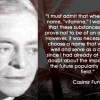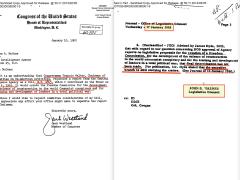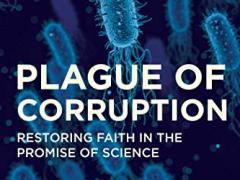Midden jaren zestig sloeg de opkomende consumentenactivist Ralph Nader alarm over het feit dat de automobielmakers volgens hem bewust auto's van mindere kwaliteit en lagere veiligheid produceerden. Op die manier werden consumenten, zonder dat ze het vermoeden, ertoe gedwongen op sneller een nieuwe auto te kopen. De econoom George Akerlof maakte hiervan gebruik om zijn theorie van "markets for lemons" op te zetten waarbij verkopers altijd beter geïnformeerd zijn over het product dat ze aan de man brengen dat de kopers. Producenten steken bewust "fouten" in hun product waarvan de koper niet op de hoogte is.
Dit zou volgens Akerlof ertoe kunnen leiden dat slechte producten, goederen van betere kwaliteit uit de markt duwen. Dit leidt op zijn beurt tot een toenemend wantrouwen vanwege de consument. Hierdoor ontstaat een neerwaartse spiraal die volgens Akerlof uiteindelijk kan leiden tot een volledig instorten van de markt in kwestie.
Of de theorie van Akerlof zich in de praktijk ook werkelijk voordoet is echter heel twijfelachtig. In de praktijk blijken er heel wat correctiemechanismen te bestaan om dergelijke negatieve spiraal te doorbreken of zelfs te voorkomen. Zo kunnen kopers zich laten bijstaan en informeren door consumentenorganisaties.
Ook vrijhandel kan een oplossing bieden zoals het voorbeeld van de auto-industrie laat zien. De strategie van de Amerikaanse autofabrikanten om auto's van mindere kwaliteit op de markt te brengen mislukte totaal nadat Duitse en Japanse producenten een gat in de markt zagen en de Amerikanen auto's van goede kwaliteit aanboden tegen een lagere prijs. Spijtig genoeg is Nader een groot tegenstander van vrijhandel. Hij en linkse economen als Akerlof menen immers dat enkel overheidsregulering, en niet de markt zelf, voor een oplossing kan zorgen.
Dit gezegd zijnde is er echter één industrie waar Akerlof (en Nader) een punt hebben: de farmaceutische industrie. De farmaceutische industrie is het voorbeeld bij uitstek van een "market for lemons", zoals Donald W. Light en Joël Lexchin, aantonen in deze paper. En in tegenstelling dat vele andere industrieën lijken de traditionele correctiemechanismes hier afwezig. Zelfs overheidsregulering lijkt geen oplossing te bieden, zoals we verderop zullen betogen.
Dit vaststelling lijkt niet onbelangrijk in het licht van de covidvaccins waarmee men nu de hele bevolking wil vaccineren.
Hoewel de farmaceutische industrie een toonvoorbeeld is van een "market for lemons", werkt het in dit geval op een andere manier dan in de theorie van Akerlof. In plaats van een negatieve spiraal die finaal leidt tot een ineenstorting, is er hier meer sprake van een subtiele interactie tussen producten en regulators.
Telkens wanneer er zich een "lemon"-situatie voordoet - een situatie dus waarbij veel gebruikers grote schade wordt berokkend door een of ander medicijn - treedt de overheid of de regulator op om een herhaling van dergelijke situaties te voorkomen. Daardoor treedt er bij de consumenten een zekere geruststelling op. Ok, DIT medicijn heeft weliswaar geleid tot heel veel problemen, maar dat gaat vanaf nu niet meer gebeuren. Tot het volgende incident plaatsvindt, waarbij het ganse proces weer van vooraf aan begint. Enzovoorts, tot in het oneindige.
Light en Lexchin geven in hun paper hiervan diverse voorbeelden. Het is heel leerrijke literatuur, maar in het vervolg van dit artikel zou ik stil willen blijven staan bij de belangrijkste methode waarmee farmaceutische bedrijven en regulatoren proberen om patiënten en medische professionals zo veel als mogelijk in het duister te laten omtrent mogelijke medische "lemons": de randomized control trial of RCT.
Vooraleer in te gaan op de diverse trucs die daarbij worden gebruikt, moet ik eerst even uitleggen wat een RCT is. Een RCT is een klinisch onderzoek waarbij men nagaat of (in dit geval) een medicijn of vaccin effectief en veilig is. Een RCT is een uitstekend middel om een oorzakelijk verband vast te stellen tussen een bepaalde behandeling en een herstel van een of andere aandoening. Om dit aan te kunnen tonen deelt men de proefpersonen op in twee groepen: één groep krijgt het medicijn (of vaccin), terwijl de andere groep een placebo krijgt. RCT's zijn meestal dubbelblindstudies wat betekent dat noch de onderzoekers, noch de proefpersonen op voorhand weten wie het medicijn en wie het placebo krijgt. Op die manier wordt elke vorm van "bias" uitgeschakeld.
RCT's worden dan ook terecht de "gouden standaard" in het (klinisch) onderzoek genoemd. Regulatoren eisen dan ook dat voordat een medicijn wordt goedgekeurd er een RCT plaatsvindt. Een RCT is dus voor de farmaceutische industrie een noodzakelijke voorwaarde om een product op de markt te brengen.
De meeste van die RCT's gebeuren dan ook door de farmaceutische industrie zelf of door onderzoekers die door hen worden ingehuurd. De farmaceutische bedrijven zijn er immers op gebrand dat zo'n RCT het gewenste resultaat op levert. En zij beschikken daarvoor over een heel arsenaal van middelen. Light en Lexchin zelf belichten een achttal van dergelijke trucs:
1) Bij de selectie van de groepen neemt men net die proefpersonen waarvan men op voorhand weet dat de positieve effecten het grootst zijn en de nadelige gevolgen worden geminimaliseerd. Bijvoorbeeld: oudere mensen of mensen met onderliggende ziekten worden meestal uitgesloten van dergelijk onderzoek. Zo ook zwangere vrouwen.
2) Door de lengte van het onderzoek te manipuleren kan men het onderzoek net zo lang laten lopen opdat de voordelen maximaal zijn, terwijl de bijwerkingen nog niet opgemerkt worden.
3) Onderzoeksprotocollen kunnen zo worden opgesteld dat men slechts een beperkt aantal negatieve bijwerkingen onderzoekt, maar niet andere.
4) Uitvallers (wegens te zware bijwerkingen) laat men volledig weg uit de resultaten, waardoor die resultaten er beter uitzien dan wanneer men de uitvallers zou opnemen. Een voorbeeld. Stel er zijn 100 proefkonijnen waarvan 20 te maken krijgen met zware bijwerkingen. Van die 20 vallen er 10 uit. Als men die 10 zou opnemen in de resultaten hebben 20 op 100 deelnemers te maken met zware bewerkingen of 1 op 5. Als men die 10 er uit laat wordt het resultaat 10 op 90 of 1 op 9. Welke is de juiste weergave van de feiten? Het oordeel laat ik aan de lezer.
5) Met statistische technieken kan men laten uitschijnen dat de bijwerkingen niet-significant zijn.
6) Soms gebruikt men niet een placebo, maar een andere medicijn, waarvan men op voorhand weet dat de resultaten ervan slechter zijn.
7) Door manipulatie van de doses kan men eveneens het gewenste resultaat verkrijgen.
8) Als variatie op truc 2 kan men ook een onderzoek voortijdig stopzetten indien de resultaten zeer positief zijn, zelfs wanneer men weet goed dat de resultaten niet representatief zijn.
9) Als variatie op truc 3 kan het onderzoek zo ontworpen zijn dat men enkel test voor een specifiek (positief) resultaat.
Nu is dit geenszins bedoeld als kritiek op RCT's op zich, hoewel het zeker geen waterdichte techniek is. En bij vele RCT's worden de regels van de kunst wel degelijk gerespecteerd. Zoals eerder aangehaald, zijn ze de gouden standaard in dit soort onderzoek; en we zijn dan ook genoodzaakt om er gebruik van te maken.
Het punt is dat wanneer RCT's gebruikt worden voor een specifiek doel, met name het verkrijgen van een toestemming om een nieuw product op de markt te brengen; we er van moeten uitgaan dat de bedrijven die het onderzoek doen of laten doen, een belangrijke incentive hebben om een zo gunstig mogelijke uitkomst te bereiken. Kortom, de hiervoor vermelde strategieën om de resultaten van een RCT op te smukken en de negatieve effecten te minimaliseren is een volkomen RATIONELE uitkomst van het gedrag van bedrijven die heel gretig nieuwe producten aan de man willen brengen.
We krijgen dus precies het omgekeerde fenomeen dan voorspelt door Akerlof. In plaats van het ineenstorten van de industrie krijgen we net een industrie die uit zijn voegen barst, die alsmaar meer consumenten en dus zieken nodig heeft om zijn medicijnen aan te kunnen verslijten. En wat is er dan handiger dan een virus waardoor iedereen - de ganse wereldbevolking in feite - een patiënt wordt die regelmatig moet getest en gevaccineerd worden. Zoals Abba zong:
Money, money, money
Must be funny
In the rich man's world
Money, money, money
Always sunny
In the rich man's world
De natte droom van Big Pharma werd dus dankzij corona de realiteit, net op het moment dat het traditionele business model van Big Pharma op springen staat en enkel biotechbedrijven zoals Moderna & bioNTech voor de redding kunnen zorgen.
Echt wel héél toevallig niet?
Ja, hoor ik u nu zeggen, maar wat dan met de regulatoren? Die weten dat toch ook? Die kennen die strategieën toch ook?
Probleem is dat de bedrijven vaak cruciale informatie voor de regulatoren verborgen houden. Verschillende studies over zowel het Europese Medicijnenagentschap als zijn Amerikaanse tegenhanger (FDA) tonen aan de de regulatoren vaak hun eigen regels overtreden om toch medicijnen goed te keuren zelfs indien ze niet volledig werden ingelicht. Ondanks het bestaan van deze regulatoren worden voortdurende nieuwe "lemons" op de markt gebracht. Denk aan de opiatencrisis die aan 400.000 Amerikanen het leven heeft gekost.
Hoe kunnen we dit nu toepassen op de vaccins tegen corona die zopas op de markt werden gebracht (en die overigens enkel een noodgoedkeuring hebben gekregen van de EMA en de FDA, geen definitieve, omdat de onderzoeken nog niet afgerond zijn)? Zou het logisch zijn om aan te nemen dat de producenten nu wel op volkomen eerlijke en transparante manier die onderzoeken hebben verricht, zoals door velen wordt beweerd, zoals de vaccinoloog Pierre Van Damme (die veel onderzoeksgelden krijgt van de Bill and Melinda Gates Foundation)?
Australisch onafhankelijk onderzoeker Anthony Colpo beweert van niet. In een reeks artikelen stelt hij vast dat bedrijven zoals Pfizer, Moderna en Astra Zeneca een loopje hebben genomen met de regels. Niet alleen dat, zelfs uit hun eigen gemanipuleerd onderzoek blijkt dat de resultaten minder gunstig zijn dan in de media wordt voorgesteld. In een volgende post zal ik deze ontluisterende artikelenreeks overlopen.
Maar om de vraag te beantwoorden, moeten we niet naar de onderzoeken zelf kijken, maar naar de geschiedenis van enkele van die producenten, met name bioNTech en Moderna. Zowel bioNTech als Moderna zijn vrij jonge ondernemingen (Moderna bestaat 10 jaar) die gedurende hun bestaan op basis van een nieuwe techniek - mRNA - al talloze pogingen hebben ondernomen op nieuwe medicijnen en/of behandelingen op de markt te brengen. Het resultaat is verbijsterend: geen enkele van de pogingen zijn gelukt. Noch bioNTech, noch Moderna hebben ooit één medicijn ontwikkeld dat door fase 2 van de testen is geraakt.
Beide bedrijven hebben vervolgens ervoor geopteerd om via mRNA vaccins gaan te maken.
En net toen brak Sars-cov-2 uit.
En toen lukte het plotseling wel! Stefan Bancel, de CEO van Moderna (en intussen multimiljardair) wist het met zekerheid aan Trump te vertellen: binnen de kortste keren (at warpspeed) zou Moderna een vaccin uit de hoed toveren, op basis van een, dixit CNN, onbewezen technologie. Enkele weken later gingen de eerste testen van start, en nog geen jaar later hadden we al zeker 3 vaccins (het Russisch vaccin even niet meegeteld), waarvan 2 op basis van de mRNA-techniek.
En net hier zouden we moeten geloven dat die bedrijven op volstrekt irrationele wijze (vergeet niet dat het manipuleren van RCT's volkomen rationeel is) hun onderzoeken niet zouden hebben gemanipuleerd? En dat in de persmededelingen van die bedrijven (en de gepubliceerde RCT's) de waarheid en niets dan de waarheid staat?
Het oordeel is aan u!
Addendum
Wat volgt zijn mijn Kindle-notities van het boek The Risks of Prescription Drugs door één van de auteurs van bovenvermeld artikel. Het gaat nog veel uitgebreider in op de problematiek die hierboven slechts summier wordt geschetst.
- De risico's van geneesmiddelengebruik zijn bijzonder groot:
A review of studies in 1998 concluded that “ overall 2,216,000 hospital patients experienced a serious ADR ( adverse drug reaction ) in the United States in 1994 . ” 4 An estimated 106,000 died , making adverse drug reactions the fourth leading cause of death , behind stroke but ahead of pulmonary disease and accidents . 5 The authors called the rates “ extremely high . ” Applying the same rates to the most recent census data projects 2,335,000 ADRs among hospitalized patients and 111,136 deaths in 2006.6 Risks increase with age as the ability of the kidney and liver to excrete drugs declines . Starfield , in a wider review of adverse effects , concludes that at least 225,000 patients die each year from all forms of medicine in a system prone to fragmented , excessive treatment . 7 Adverse drug reactions reported to the FDA nearly tripled between 1995 and 2005 , from 156,000 to 460,000 ( figure 1.1 ) . 8 A decade earlier , in 1985 , only 38,000 reports were submitted . According to Public Citizen , 1.5 million Americans a year are hospitalized due to adverse drug reactions . 9 If Americans consume about 40 % of all drugs in the world , this would mean 3.75 million hospitalizations worldwide . Between 1998 and 2005 , reported serious adverse events increased four times faster than the total number of outpatient prescriptions . These studies each have their limitations, but together they indicate how substantial are the risks that patients bear. - En de situatie wordt er niet beter op, integendeel:
There is no sign of the increase leveling out . Assuming a constant reporting rate , ADRs are rising about 15 % each year , and a shift to biologics as safer because more “ natural ” is offering no relief . A study of the new biologics has found that safety - related regulatory action was taken on 14 % of them within the first three years on the market and 29 % within the first 10 years . 10 Seventy percent of the serious side effects were identified within the first five years of use , and the other 30 % in the next five years . First - in - class ( breakthrough ) biologics were 3.7 times more likely to result in a safety warning than biologics in existing classes. - En de risico's worden wellicht ook nog eens sterk onderschat omdat vele effecten van geneesmiddelen niet worden gemeld (in vele gevallen is de voorschrijvende arts ook de arts die de doodsakte moet invullen):
There are good reasons to believe that toxic side effects are even more widespread than the figures above . Former FDA Commissioner David Kessler has written that “ only about 1 % of serious events are reported to the FDA , ” and the FDA Office of Drug Safety believes only 1 % of ADRs are reported , 12 which for 2005 would mean about 46 million adverse drug reactions . The review of studies did not count ADRs due to overdose , errors in drug administration , and other factors that are extrinsic to the drugs themselves ; rather the review found an emphasis on high dosages throughout the current system , massive commercial promotion , and the use of brand names that look or sound similar . 13 These include a substantial number of young adults 18 – 25 who take psychotherapeutic drugs , stimulants , and sedatives obtained outside the regulated market for non - medical uses . 14 Many researchers also do not count serious ADRs or deaths in nursing homes or anywhere outside hospitals . More important are the factors that the prize - winning New York Times journalist Melody Petersen identifies in her book Our Daily Meds . 15 When drugs make patients dizzy , resulting in a bad fall , or drowsy , resulting in a car accident , or less able to fight off a serious illness because of a weakened immune system , official reports cite the bad fall , the car accident , or the new disease , not the underlying problem of drug side effects . Petersen reports that doctors who fill out death certificates are instructed to call a “ therapeutic misadventure ” a natural death . The role of a drug in a heart attack or stroke or in liver failure is usually not noted . Yet when pathologists have investigated liver failure cases more thoroughly , for example , they have found that 51 % were caused by just one active ingredient , acetaminophen , which is sold as Tylenol and is combined with many other drugs . 16 Petersen cites other in - depth studies that find drugs as an underlying cause of death in which the prescribing doctor is often the one who fills out the death certificate. - Er is duidelijk sprake van overgebruik van geneesmiddelen, en patiënten belanden vaak in een vicieuze circel:
The number of prescriptions increased 72 % from 1997 to 2007 , much faster than increased illness due to aging or other factors . 17 More people are taking drugs longer , for months or years , and the risk of side effects rises with length of use .
In addition , the risk of drug interactions increases rapidly as a patient takes more drugs .There can be a cascade effect , as additional drugs are prescribed to deal with the harmful side effects of initially prescribed drugs , these may also generate their own side effects . For all these reasons , the individualized risk of taking prescription drugs is probably much larger than estimates based on hospitalized patients . Patients may reasonably expect the FDA and their physician to protect them from risk , but in fact , both pass significant risk on to patients . - Nieuwe medicijnen zijn meestal niet beter dan bestaande:
On average , most new drugs offer little or no additional benefit over existing drugs to offset their risks . A careful review of therapeutic benefits and harms for each new drug over the past two decades has concluded that 2 – 3 % are real breakthroughs and another 11 % offer some advantage over existing drugs , for a total of 14 % , or one in seven . 20 In the 1960s and 1970s , when the FDA used to rate the therapeutic contributions of new drugs precisely , it judged 2.1 % of 1,861 drug candidates as therapeutic breakthroughs and 8.6 % as modestly superior . 21 Together these indicate that one in nine new drugs offer a modest or significant therapeutic gain , the same ratio that an often - cited industry assessment found for all internationally marketed drugs from 1975 to 1994.22 Thus for over 40 years , most new drugs have offered few advantages to offset risks , and only a small proportion have provided real clinical advantages over existing ones . 23 Those 11 – 14 % of new drugs that offer real therapeutic advantages have helped millions of patients , and if there are two or three new ones a year , they add up over time to a significant arsenal against disease and death . - Farmaceutische industrie spendeert weinig geld aan fundamenteel onderzoek:
Pharmaceutical company reports show they spend only 1.3 % of sales revenues for basic research to discover new drugs , net of taxpayers ’ subsidies . - Gelukkig zijn er consumentengroeperingen om de burger te helpen:
The Health Research Group at Public Citizen has been primarily concerned about drug safety for 30 years and is funded by subscriptions and donations . It has identified more than 180 approved drugs that are too toxic for patients to take . In many cases the FDA approved them despite evidence of serious risks or little advantage over other drugs . They include such well - known products as Bextra , Celebrex , Crestor , Lamisil , Levitra , and Singulair , some of which had warnings added or were withdrawn after the Health Research Group advised against them . 26 The Group is constantly petitioning the FDA to ban further dangerous drugs , like the widely used drug for diabetes , Avandia . - Over het begrip "effectiviteit" (veel gehoord tegenwoordig)
When pharmaceutical companies say a drug is “ effective ” or “ more effective , ” they usually mean more effective than a placebo , not more effective than existing drugs . In fact , the FDA is not allowed to compare a new drug to drugs already on the market in considering approval . “ - De effectiviteit en veiligheid van veel medicijnen is pure mythologie:
Soft , surrogate end points are used in clinical trials on the assumption that lowering blood sugar has a clinical benefit that outweighs the risks in type 2 diabetes . A recent study at the Cleveland Clinic , however , challenges this assumption for one class of anti - diabetic drugs , which includes Actos ® , Avandia ® ( rosiglitazone ) , and Rezulin ® ( troglitazone , which is no longer marketed due to liver toxicities ) . In fact , the Cleveland Clinic meta - analysis of many clinical trials suggests that these drugs actually increase patient risk of a cardiovascular event ; yet millions of people are still taking them. The rules and practices by which so many new drugs of little benefit and real risk get approved and marketed reflect the hope and optimism that characterize American culture . 37 Fears and uncertainties about symptoms and illnesses foster magical thinking. - Dokters staan te vaak aan de kant van Big Pharma ipv. de patiënt:
Although they probably do not see it this way , physicians provide the perfect cover for drug companies : rather than serving as a trusted protector of their patients , they prescribe without mentioning adverse reactions and then dismiss them when they arise . - De FDA vormt geen hinderpaal voor de winstbeluste industrie:
Research into the details of how the FDA approves drugs has found that it approves them with partial evidence of harmful effects or sometimes before the results of an important trial are in , and sometimes despite known risks , because it is under great pressure by companies and patients to get new drugs on the market . 56 The FDA increases risk this way through quick approvals that require post - approval trials , most of which are not completed . 57 The FDA Office of Drug Safety has limited staff or funds to monitor safety once drugs are on the market and few powers to restrict or withdraw a dangerous drug . It repeatedly recommends that dangerous drugs be taken off the market but is overruled by the body that approved them . The officers in charge are known to be both skeptical of the evidence coming in and reluctant to admit they approved a drug that is harming patients.
From my research , I have concluded that five institutional practices make up what could be called the risk proliferation syndrome : ( 1 ) having companies test their own products as part of a public regulatory system ; ( 2 ) limiting reviewers ’ time so that they are unable to thoroughly assess the available data ; ( 3 ) allowing mass marketing of new products when their safety is only partly known ; ( 4 ) providing strong incentives to encourage unapproved uses ; and ( 5 ) supporting the proliferation of new disease models that lack good evidence but lead millions of patients to take unnecessary drugs with their attendant risks . - Hoe onderzoek en de bekendmaking van de resultaten wordt gemanipuleerd (zie hierboven):
Companies often design trials around patients with a principal condition who are otherwise healthy . For example , Merck ruled out patients with existing cardiovascular problems for critical trials of Vioxx , even though cardiovascular risks were “ in the mechanism ” of how the drug worked and may have been suspected from the beginning . 79 If the same companies that have invested millions to develop a drug also design the trials to test its safety and efficacy , we can expect them to use strategies like these to produce “ scientific ” evidence that they are safe and effective . The Office of the Inspector General repeatedly investigates conflict of interest ( COI ) and routinely finds that the FDA does not enforce regulations to protect the public from COI because there is an inherent conflict in having companies test their own products .
Sponsoring companies also engage in “ ghost management ” of research and publication to make it appear as if academic researchers are doing the studies and authoring scientific articles on the results . 80 Companies also manage what gets published and what does not . For example , one analysis found that 97 % of antidepressant trials deemed positive by the FDA were published , whereas only 12 % of trials with negative results were published and another 21 % of the trials that the FDA judged to contain negative results were published so as to appear positive ( see figure 1.3 ) . 81 If the results from the negative trials are added to the published positive results , antidepressants are found to be barely more effective than placebos and to have serious side effects , a picture that was hidden for years . 82 Another review of generic and brand - name drugs for cardiovascular disease found that nearly all trials concluded they were equivalent , but half the editorials in medical journals counseled against using generics . 83 A related bias in analysis and publication arises from not testing a hypothesis with trial data but doing scores of correlations and picking out the ones that are significant and favorable to the drug . - Experten en industrie hebben een symbiotische relatie:
Thus , a symbiotic relationship developed between specialists promoting prescription - based drugs and their manufacturers to enhance each other’s power and legitimacy that has continued from before the beginning of the era of effective drugs in the 1930s . Drugs sold as higher quality and physician - endorsed also justified higher prices and profits . - Medicijnen met een voorschrift zijn niet noodzakelijk veiliger, integendeel:
The new law also made safety requirements less stringent if the drugs had to be prescribed by a physician . To ease its regulatory burden , the FDA began to assign most new drugs to the “ prescription only ” category , thus passing on responsibility for safety to physicians . Historian Peter Temin believes this change represented a loss in consumer sovereignty and a new layer of regulatory gatekeeping by licensed physicians . 12 But the industry saw the advantages of having to market only to physicians rather than to the entire nation and vigorously promoted the institutional construction of “ prescription drugs ” as a prevalent legal and commercial category .
Working with companies and improving review procedures paid off . The average time for standard reviews dropped from thirty - three months in 1987 to nineteen months in 1992 , then to sixteen months by 1994 . Nevertheless , Representative Newt Gingrich launched a campaign through his Progress and Freedom Foundation to eliminate the FDA . The Washington Legal Foundation published ads claiming that delays in approval had killed at least twenty - five hundred kidney cancer patients who could not get Interleukin - 2 while the FDA reviewed the drug and caused fourteen thousand patients to have heart attacks because they could not benefit from the CardioPump during its two - year review . 45 The facts did not support these allegations , and industry leaders became worried that the vitriolic attack could kill the goose ( the FDA ) that was laying the golden eggs , FDA - approved drugs . FDA procedures could hardly have been regarded as hostile to the industry . On the contrary , as described in Chapter 1 , they let through a substantial number of drugs that had serious risks . Thomas Moore of George Washington University estimated that lifetime chances of severe injury from auto accidents were two in one hundred but twenty - six in one hundred from prescription drugs . 46 Hearings in May 1996 led to the campaign being discredited and the bill dying in committee , but they highlighted the business view that the less regulation the better so that new products can get on the market quickly . 47 The way to maximize product availability is not to regulate at all ; let companies develop what drugs they want , test them as they see best , and sell them . This view is put forward by industry - friendly authors and journalists to this day , without consideration that uncertainty surrounds the risks of all new drugs and only a few provide offsetting advantages . 48 - FDA wordt deel gefinancieerd door de industrie zelf (meer dan 50%!) Idem voor CDC:
Corporate fees have gone from about one - tenth of total FDA funding to more than half. - Dokters en industrie hebben innige banden.:
If Doctor A did not have extensive interactions with the drug industry , he’d be quite unusual . A survey of U.S . physicians revealed that 94 % reported some sort of relationship with the industry . Eighty - three percent accepted gifts from sales representatives ranging from pens , notepads , and coffee mugs to expensive dinners and trips to resort locations for conferences ; 78 % took promotional samples to give to patients ; and 35 % received reimbursements from industry as paid consultants or speakers . 4 With the new Code of Conduct in force , the gifts have become less prevalent .
(P)hysicians admit to accepting some gifts or payments from the pharmaceutical industry . The vast majority receive far lower sums than these few privileged academics ( dubbed “ key opinion leaders ” by industry ) . 15 Nonetheless , it also seems clear that Senator Grassley did not have to dig very deep in order to discover newsworthy , egregious cases . A few months before Senator Grassley’s revelations , a lawsuit against five manufacturers of implanted artificial joints was settled , revealing that some leading orthopedic surgeons had been paid a million dollars or more , ostensibly as consultants but more likely as a reward for frequent use of a manufacturer’s product . 16 Multiple examples could be found indefinitely . - De marketinguitaven zijn enorm, veel geld gaat naar doktoer, maar op die manier beïnvloed de farmaceutische industrie ook wetenschappelijke tijdschriften en de MSM:
The U.S . pharmaceutical industry spends as much as $ 57 billion annually marketing drugs , with all but about $ 4 billion aimed directly at physicians . 17 Companies can readily purchase information on which physicians write how many prescriptions for each of their products ( completely legal since no patient names are revealed ) . Armed with these prescribing data , sales representatives can dole out largesse in proportion to each physician’s value to the company as a prescriber . Low prescribers may get only notepads and coffee mugs emblazoned with a drug logo . Higher prescribers will regularly be invited to dinners at luxury restaurants , perhaps even being paid as “ consultants ” merely to attend . Still higher prescribers will be hired as part of the company’s speakers ’ bureau , supposedly because they have unique expertise in how to use the drug , but in actuality as yet one more financial reward for their prescribing practices . 18 An investigation in Minnesota , made possible by that state’s sunshine law requiring the reporting of industry payments , revealed that fully one - quarter of the state’s child psychiatrists are members of a company speakers ’ bureau , leaving us to wonder who might be left to constitute the audience . 19 Social scientists can predict with confidence that these gifts will form a bond of reciprocity between the sales representative or company and the physician . 20 Normal human psychology creates an often subconscious impulse to give back to those who have given us gifts . 21
(T)he scientists conducting the research too closely identify their interests with those of the sponsoring drug companies and minimize evidence of risks , where else can the public turn for protection ? Medical journals , for example , ought to serve as citadels of good science , refusing to publish research papers that use biased samples , methods , and analysis . Sadly , the major journals have at least two big financial incentives to publish commercially sponsored research with little editorial oversight . First , pharmaceutical companies pay for the advertisements that keep most journals solvent and have been known to withdraw their advertising largesse from journals that seem opposed to company interests . More important , when a successful drug trial is published , the company typically purchases thousands of reprints of the article for distribution by its sales force . These reprints amount to almost pure profit for the journal . 28 Both the New England Journal of Medicine and the Journal of the American Medical Association allowed an underreporting of toxic side effects in major articles about the benefits of Vioxx and Celebrex , which then became key tools for massive prescribing of both . Merck paid the New England Journal of Medicine $ 900,000 for reprints of one article . It is very hard to detect exactly where the breakdowns occur in the editorial review process in such cases since journals treat their peer review systems as both confidential and proprietary and are very secretive about their inner workings . The end result , however , is that journals frequently fail to protect the medical consumer from the risks of drugs . - Deze ongezonde dominantie van de farmaceutische industrie leidt tot overconsumtie. De gevolgen zijn nefast. Ziekten worden uitgevonden om medicijnen te kunnen verkopen:
This precipitous rise in antidepressant use should set off a number of alarms . First , like the ADHD diagnoses , the DSM criteria for MDD do not distinguish intense but normal sadness that can arise from breaking up with a boyfriend or girlfriend , failing an important test , or getting punished by parents from depressive disorders . Many young people who are responding to stressful circumstances might be mistakenly labeled as depressed and unnecessarily medicated . Even when MDD diagnoses are appropriate , antidepressants might not be an effective tool for treating depression among children and adolescents . One large analysis of all studies of this question among preteens indicates that improvement among those who are medicated barely exceeds placebo treatment : 58 % of children respond to placebo compared to 65 % who receive active medication . 14 All antidepressants have adverse reactions , and these can be especially potent among the young . Because the widespread use of antidepressants among the young is so new , no studies are available about risks of adverse effects from their long - term use .
A particular concern lies in possible increased risk of suicidal behavior among young people who take antidepressants . Several studies show reports of suicidal ideation and / or behavior are greater among those taking antidepressants than those who receive placebos . 15 One important case control study of children and adolescents aged 6 to 18 who were hospitalized for depression showed that youths treated with antidepressants had 1.52 times more suicide attempts or deaths from suicide than those who did not receive antidepressant drugs .
It is unlikely to be coincidental that the vast increase in diagnoses and prescriptions among the young has occurred at the same time as older psychotropic medications were coming off their patents . The income from once hugely profitable drugs plunges after their patents expire and generics enter the market . 23 This forces drug companies to adapt old medications to new , patentable uses or to find new populations , such as ever - younger users , for their products . Skepticism over the legitimacy of the pediatric bipolar diagnosis and resulting medication treatments is fueled by the fact that their leading promoter , child psychiatrist Joseph Biederman , has received at least $ 1.6 million in consulting fees from the drug industry in recent years . 24 The result , in all likelihood , is that millions of young people are at risk for careers of drug use for disorders that barely existed ten years ago . - Het is eigenlijk een vorm van uitbuiting van de "patiënt" door de farmaceutische industrie, en covid-19 maakt de zaak alleen maar erger: zelfs een snotvalling is tegenwoordig een "ziekte", sterker nog, mensen zonder symptomen wordt als besmettelijken behandeld. Dit is eigenlijk een logische conclusie van de manier waarop Big Pharma, met medewerking van overheid en media met de mensen omgaat:
The pharmaceutical industry has exploited the large numbers of presumably mentally ill people , using their advertising , marketing , and educational campaigns . Correspondingly , there has been a sharp increase in the number of prescriptions written for psychotropic drugs . During the last decade of the twentieth century , the psychiatric drug market grew by a phenomenal 638 % in the United States . 29 The development and intensive marketing of selective serotonin reuptake inhibitors ( SSRIs ) in the late 1980s were largely responsible for this growth . By the turn of the century , spending on psychotropic drugs had reached $ 20 billion annually . At this time , three of the top seven bestselling drugs of any sort ( Prozac , Paxil , Zoloft ) were antidepressants . Three examples illustrate the explosive growth in medicalization among adults : major depressive disorder , social anxiety disorder , and sexual dysfunctional disorder .
It is becoming increasingly clear that the enormous rise in apparent mental illness and the use of drugs to treat it does not result from medicine’s greater ability to identify and treat diseases that went unrecognized in the past . 57 Medicalization has created many of the conditions that it claims to treat . 58 Some of these conditions , such as pediatric bipolar disorder or social phobia , barely existed until recently . Others , including ADHD , Major Depressive Disorder , and sexual dysfunction , were well - recognized disorders , but medicalization has greatly broadened the criteria that define them . - Hoe keren we het proces om?
How do we demedicalize health problems in a world in which two - thirds of patient groups receive funding from drug companies , published studies understate harms and overstate benefits , expert panels who set guidelines are made up of specialists with financial ties to drug companies , and most of the medical societies that run courses and conferences receive large contributions from drug companies ?
Drug companies spend billions of dollars on physicians to persuade them to depart from their own clinical judgment in prescribing ; this commercial influence is so great that it can overcome solid evidence that a drug is dangerous . For example , the New York Times published an article about the paltry impact of a six - year independent study completed in 2002 of newer and older drugs for hypertension , the ALLHAT ( Antihypertensive and Lipid - Lowering Treatment to Prevent Heart Attack Trial ) study . It found that Norvasc ( a Pfizer drug ) increased chances of heart failure by 38 % with few offsetting benefits compared to old diuretics that cost one - twentieth as much . 15 AstraZeneca’s ACE inhibitor was also more risky , and Pfizer’s Cardura doubled the risk of hospitalization for health failure . Like company responses to evidence that Vioxx was dangerous ( see Chapter 1 ) and to evidence that HRT did more harm than good ( see Chapter 5 ) , Pfizer issued scripted responses for sales reps to reassure doctors that Cardura was safe and to downplay or recast ALLHAT’s negative findings . In a medical ad it turned the negative findings of the authoritative study on their head by proclaiming “ ALL HATs off ” to its drug . Pfizer’s CEO said , “ Allhat is extremely positive for Norvasc . ” Spin trumped science and safety . Sales increased , from $ 3.7 billion in 2002 ( when the study results were published ) to $ 4.9 billion in 2006 . Based on the trial results , this means that many more patients were exposed to serious risks of heart failure by taking expensive drugs that provided no advantage over diuretics . - Kortom, de situatie ziet er niet goed uit. We leven in een medische dictatuur, en de media zullen er ons niet uithalen. We gaan het zelf moeten doen!











